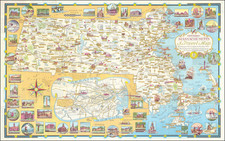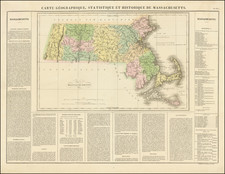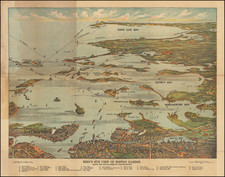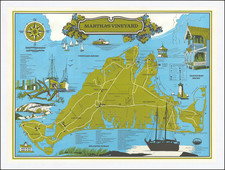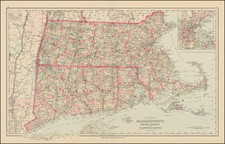Birthplace of Presidents
Edwin Whitefield's 1878 bird's eye view of Quincy, Massachusetts offers a straightforward representation of the town. Whitefield chose a southern vantage point, looking slightly northeast towards Boston Bay. From this perspective, viewers can see the transition from the bay, through open rural land, and into the town proper.
The map is practical, with the streets clearly labeled. It does not offer detailed illustrations or insets of individual buildings, but instead includes a legend that identifies thirteen notable structures. These include the town hall, five churches, four schools, and the birthplaces of John and John Quincy Adams.
An essential aspect of Quincy's economy, its granite quarries, can be seen in the lower left corner at the end of Granite and Quarry Streets. In the upper right corner, the presence of docks and shipyards suggests Quincy's maritime activities.
In this depiction, Whitefield visually centers some of Quincy's enduring landmarks, particularly the Adams birthplaces and the quarries. The railway, another crucial aspect of Quincy's infrastructure, bisects the town in this view. Overall, Whitefield's 1878 view of Quincy combines function and form, presenting a well-organized and visually appealing map that conveys a sense of Quincy's geography, architecture, and economic activities.
Quincy
Quincy has a rich history that unfolded in a remarkable manner throughout the 19th century. At the beginning of the century, Quincy was primarily a rural town, known for its farming and granite quarrying industries. The town was incorporated in 1792, named after Colonel John Quincy, the maternal grandfather of Abigail Adams and the great-grandfather of John Quincy Adams.
The Adams family has a deep connection to Quincy, with two U.S. presidents, John Adams and his son, John Quincy Adams, born here. Their birthplaces, marked on the map, are now part of the Adams National Historical Park. Quincy's granite industry flourished in the 19th century and supplied stone for notable structures like the Bunker Hill Monument.
In the second half of the century, the town experienced industrial growth, particularly in shipbuilding. This industry significantly impacted Quincy's development, and by the end of the 19th century, Quincy was not just a rural town but also an industrial center.
Edwin Whitefield
Edwin Whitefield was born in England in 1816 and moved to the United States around 1849. Known as a landscape artist, Whitefield gained recognition for his series of town views, particularly in New England. He took a novel approach to cartography by illustrating townscapes in a bird's eye view, which provided a more detailed representation of the urban landscape than conventional maps. This unique perspective not only showcased Whitefield's artistic prowess but also offered a fascinating glimpse into the evolution of American cities and towns in the 19th century.
Whitefield's work in Quincy, Massachusetts, came during a period of prolific output. During this time, he traveled extensively, documenting the landscapes and architecture he encountered. Whitefield's work serves as a valuable record of 19th-century American towns and cities, providing insight into their growth and development during a time of significant change and expansion.









![[ New Orleans, Louisiana / Southern Travel Letter ] Lyman Adams letter to Austin Adams, December 21, 1839](https://storage.googleapis.com/raremaps/img/small/96629.jpg)
